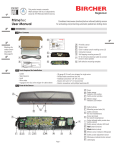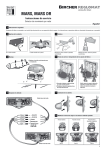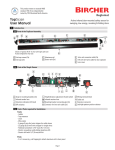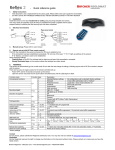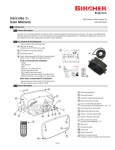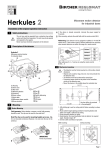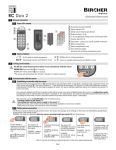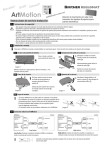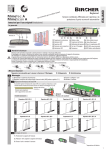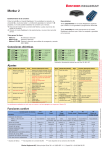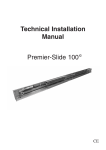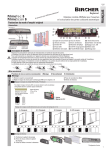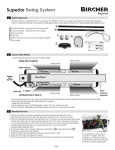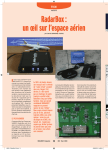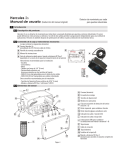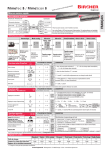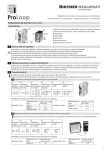Download PrimeScan User Manual
Transcript
EN ISO 9001 1” 2” Quality international level PrimeScan User Manual 1 Active infrared safety sensor for monitoring the opening edge of automatic pedestrian sliding doors Introduction 1.1 Box Contents The box contains the following items: A PrimeScan sensor B Sensor cover 3” 3” F G C 10’ (3 m) 8-wire electrical cable to connect Marking for safety curtain adjustment (See page 6) sensor to door operator Self-adhesive mounting template E Click-in safety curtain masking covers (2) F Self-tapping mounting screws (2) G Instruction manual D E B Tools required for installation: - Ladder - Tape measure - Level - Wire cutter - 4 gauge (5 mm dia.) wire stripper for cable sleeve - 26 gauge (0.14 mm²) wire stripper for single wires - Phillips head screwdriver (size #1) - Flathead screwdriver 1/8” (#1/ 3.6 mm) - Electric drill with 1/2” (12 mm) drill bit - Electric screwdriver with phillips head (size #2) A F D C 1.2 Parts of the Sensor A A Cover B Safety sensor indicator LED window C Safety curtain window D C B D E E F G H I J Cable bushing Mounting screw holes (2x) F Screw terminals (for retrofit installations) Cable connector G (for new installations) H Active infrared safety curtain lens (safety sensor) I Detection indicator LED (red) J Red button (function) K Black button (value) L Relay indicator LED (green) M Safety curtain adjustment screw N LCD display E K L M Page 1 N 2 Safety Precautions 2.1 General Safety Warning: failure to follow these safety precautions may cause damage to sensor or objects, serious personal injury, or death. -This product is designed to be mounted on the header of an automatic sliding or telescopic door. -Do not use this product other than for its specified application. -Observe all local, national, and international door safety standards, codes, and laws. -Only trained and qualified personnel may install and initialize the sensor. -Only authorized Bircher Reglomat personnel may perform hardware/software changes or repairs to the product. -The unit should only be operated from a safety extra low voltage (SELV) system with safe electrical separation. -Always consider the safety functions of your applications as a whole, never just in relation to one individual section of the system. -The installer is responsible for testing the system to ensure it meets all applicable safety standards (e.g. ANSI 156.10). -Never touch any electronic components or lenses. 2.2 Installation Safety -Follow all steps outlined in this manual in order for proper installation of the product. -Stop all pedestrian traffic through the door before installing sensor. -Ensure there is no pedestrian traffic through the door until sensor is installed and tested for compliance with all applicable safety standards (e.g. ANSI 156.10). -Verify proper installation of door equipment before installing sensor. -Shut off all power before attempting any wiring procedures. -Always use wire terminals to terminate stranded wire ends. -Check placement of wiring to ensure moving parts are not impeded by wires. -Make sure wiring is correct before applying power to the sensor to avoid damage to equipment. -Ensure door & header coverplate are properly grounded to protective earth (PE). -Ensure (e.g. by walk testing) that installation is in compliance with all applicable standards (e.g. ANSI 156.10) after completion of installation. -If the sensor sustains damages (e.g falls), replace it with a new unit. -If a satisfactory solution cannot be achieved after troubleshooting a problem, please call Bircher Reglomat at 800-252-1272 or visit our website at www.bircherreglomat.com. DO NOT LEAVE ANY PROBLEMS UNRESOLVED! DO NOT SACRIFICE SAFETY FOR ANY REASON! 3 Mounting the Sensor 3.1 Special Considerations Ensure header coverplate is always in place and held tightly by screws. Mount the PrimeScan rain cover, (PTCR) if sensor is exposed to rain. Obstruction can effect performace of sensor. Make sure safety & motion sensors have an unobstructed view. 3.2 Removing the Cover With one finger grasp the sensor base near one of the mounting screw holes and pull the sensor toward you to remove the cover. To remove cover once the sensor is mounted on the door frame, grasp the cover firmly on either side and pull toward you. Page 2 Mount sensor away from fluorescent or HID light sources. 3.3 Wiring the Sensor New installation using gray cable with plug Insert the female plug on the gray cable into the male receptacle on the sensor. Ensure the plug is fully inserted. Proper insertion of the cable with connector into receptacle Retrofit installation using detachable screw terminal The cable will only fit into the receptacle if the grooves are lined up properly. Do not force the connector into the receptacle or damage could result. Shown above is the 4-wire retrofit wiring scenario using the detachable screw terminal. Insert the proper wires into terminal (based on the wiring diagram on page 4) and tighten the screws with a 1/8” flathead screwdriver. Important note: for both options, slide the cable into the cable bushing to hold it firmly in place. Use of the cable bushing is important to prevent water from seeping into the sensor. 3.4 Routing the Cable (for retrofit installations with existing cable hole) Route the cable in the cable channels so it is flush against the back of the sensor. Several options are shown- select the best option for your environment. 3.5 Positioning & Attaching the Sensor Center of sidelite PrimeScan Self-Adhesive Mounting Template Screw hole Dia. ½” (12 mm) for cable exit Screw hole Center line (align with center of sidelight) Template Align with bottom of door header Maximum mounting height = 13’ (4 m) -1” / + 3” tolerance MT PS 0911 1. Position the self-adhesive mounting template on the door header frame in the middle of the sidelite (see illustration). Ensure template is level and the bottom of the template is approximately aligned with the bottom of the sidelite frame (-1” / + 3” tolerance). M 2. Drill hole for cable in marked location using 1/2” drill bit. 3. Using an electric screwdriver, insert self-tapping screws in marked location. 4. Remove the mounting template. 5. Attach sensor to screws and tighten to hold the sensor firmly. Page 3 4 Electrical Connections 4.1 4-Wire Connection: Standard option (Combined motion & safety outputs) New installation using gray cable with plug Black Red Cable White Green 12.9 - 33.4 VDC/ 10 - 28 VAC COM NO Retrofit installation using detachable screw terminal Power Power Safety 12.9 - 33.4 VDC/ 10 - 28 VAC COM NO 4.2 6-Wire Connection: Recommended option (Enhanced performace through separate motion & safety outputs) Sensor must be programmed for this wiring configuration. Press and hold the black value button for 8 seconds to separate motion & safety outputs. For more details, please see section 8. This option may only be used with the included gray cable. Black 12.9 - 33.4 VDC/ Power 10 - 28 VAC Red Cable White COM NO (NC) Green Relay output Brown + Blue COM NO (NC) Safety Check for correct polarity 4.3 8-Wire Connection: Best option (Additional safety through monitoring) Monitoring function is self-configurating and will be active as soon as unit is powered on if the following wiring is used. May not be available for all door operators. Sensor must be programmed for this wiring configuration. Press and hold the black value button for 8 seconds to separate motion & safety outputs. For more details, please see section 8. This option may only be used with the included gray cable. Black 12.9 - 33.4 VDC/ 10 - 28 VAC Red Power White Cable Relay output COM NO (NC) Green Brown Blue + COM NO (NC) Safety Check for correct polarity Orange Yellow + Monitoring Page 4 Check for correct polarity Safety 5 Initialization REMOVE all foreign OBJECTS that are not part of the normal door system environment BEFORE powering on. Make sure no people or moving objects are in the door area, otherwise correct startup will not be possible. Red LED Green LED The alternate flashing LED’s indicate the initialization (teach-in) of the sensor. (Duration 10 - 15 sec.) The LED’s will then remain continuously lit for 10 more seconds. Please see below for LCD screen readouts. The door system is now operational at this point. The safety/motion LED’s will only illuminate when a detection occurs. If using combined outputs (standard), the green LED will illuminate together with the red LED when a safety detection occurs. 6 Screen during initialization Safety Curtain Adjustment Screen after initialization 6.1 Adjusting the Safety Curtain Width The width of the safety curtain can be adjusted by clicking in the plastic masking cover in front of the sensor lens. Sensor without masking cover: full pattern size (factory setting) Field width: approx. 6’6” (2 m) at 7’ (2.1 m) mounting height Field depth: approx 8” (.2 m) for 2 rows Location of safety curtain masking covers inside sensor cover Rule of thumb: field width is approximately equal to mounting height. A B C D 1: Insert masking cover in slot below lens. 2: Click into place. Possible safety curtain width settings: The field size varies depending on which sections of the lens are masked by the click-in covers. Red button A B C D A B Page 5 C D A B C D A B C D 6.2 Adjusting the Safety Curtain Distance from the Door The safety curtain should be set no more than 3” (7.5 cm) away from the face of the door. Please refer to current published ANSI standard for exact measurements. 7° 2° (factory setting) 0° – + – 5° 1/8 turn » 1° » 1” For assistance, use the measuring guide on the front of the manual to determine this distance. Hold the guide no more than 10” (25 cm) off the ground and move it from the door opening into the safety field until the red LED illuminates. A 1” movement on the floor is approximately equal to 1° (45° turn with a screwdriver), Factory setting = 2° 7 Configuration (Operator Buttons) 7.1 Entering Configuration Mode Red button 1 1 Start in automatic mode Shortly press the red & black buttons simultaneously to enter configuration mode. LCD panel location Black button Once in configuration mode, the circled number in the LCD display will start to blink. Press the red button until you reach the desired function block. 1 = Motion Functions 2 = Safety Functions 1 2 = General Functions Press the black button to select the function block shown in the display. Page 6 Once all chanEnd in ges are comautomatic plete, press the mode red & black buttons simultaneously twice to return to automatic mode. Selections are saved Sensor returns to automatic mode in immediately. 60 seconds if no action is taken. Once in the desired function block, press the red button to browse through the options. Use the black button to change the value. 8 Safety Curtain Adjustment Safety Functions 2 Function (Select with RED button) LCD Values Description (Select with Factory settings in bold with * BLACK button) 2 1 Sensitivity 2, 3 2*= Regular sensitivity 3 = Snow mode 1-5 1 = 10 seconds 2*= 30 seconds 3 = 60 seconds 4 = 180 seconds 5 = 15 minutes 2 2 Teach-In Time 1* = NO 2 3 Output Logic 1, 2 2 = NC 8.4 General Settings General Settings 1 2 Function (Select with RED button) LCD Values Description (Select with Factory settings in bold with * BLACK button) 1 2 Combined/separate outputs 2 LCD after using shortcut: 1, 2 1* = 4-wire configuration (combined outputs for motion & safety) 2= 6-wire configuration (separate outputs for motion & safety) Shortcut: Press & hold black button for 8 seconds to separate motion & safety outputs 1 2 Frequency of safety curtain 3 1, 2 1 = Frequency 1 2* = Frequency 2 Please note: some settings may not meet all applicaple standards (eg. ANSI 156.10). Please see page 2 for more details. Ensure (e.g. by walk testing) that installation is in compliance with all applicable standards (e.g. ANSI 156.10) after completion of installation. 8.5 Restarting the Sensor To restart the sensor, press & hold the red button for 1 second. This is equivalent to recycling power (powering down the sensor and up again). 8.6 Factory Reset To reset the sensor to factory defaults settings, press & hold both red & black buttons simultaneously for 8 seconds. Please note: some settings may not meet all applicaple standards (eg. ANSI 156.10). Please see page 2 for more details. Ensure (e.g. by walk testing) that installation is in compliance with all applicable standards (e.g. ANSI 156.10) after completion of installation. Page 7 9 Troubleshooting 9.1 Remedying False Tripping Red LED (Safety) Green LED (Motion) On On 1 Fault Remedy Door slows or stops while opening 1. Set angle of safety curtain further away from door face (section 6.2) 1. Mount sensor away from fluorescent or HID light sources 2. Avoid puddles of water on the ground On 1 On Safety detection without apparent external influence 3. Ensure door header coverplate is always in place and held tightly by screws . 4. Avoid interference from other AIR sensors by using a different frequency setting. 5. Use snow mode. (section 8.3) 6. Use separate power supply for sensor & door operator. Off 1 Off 1. Change output logic of output (NO/NC) and use safety output (Sections 4 & 8) Door does not open *Factory settings If only safety output activated, only red indicator LED will be illuminated. If a satisfactory solution cannot be achieved after troubleshooting a problem, please call Bircher Reglomat at 800-252-1272 or visit our website at www.bircherreglomat.com. DO NOT LEAVE ANY PROBLEMS UNRESOLVED! DO NOT SACRIFICE SAFETY FOR ANY REASON! 9.2 Error Messages Red LED Green LED (Safety) (Motion) LCD Off Off 1. Power down & repower sensor or restart sensor by pressing & holding red button for 1 second 2. Clean safety curtain window on unit cover 3. If sensor displays same error or does not start, exchange device 1 2 Flashing Remedy 1. Power down & repower sensor or restart sensor by pressing & holding red button 1: Self test (RAM/ROM) for 1 second 2: Watchdog 2. If sensor displays same error or does not start, exchange device 1 Flashing Fault 2 5: Safety curtain fault 6: Safety output fault Page 8 10 FCC Approval This device complies with Part 15 of the FCC Rules and with RSS-210 of Industry Canada. Operation is subject to the following two conditions: - This device may not cause harmful interference. - This device must accept any interference received, including interference that may cause undesired operation. This equipment has been tested and found to comply with the limits for a Class B digital device, pursuant to Part 15 of the FCC Rules. These limits are designed to provide reasonable protection against harmful interference in a residential installation. This equipment generates, uses, and can radiate radio frequency energy and, if not installed and used in accordance with the instructions, may cause harmful interference to radio communications. However, there is no guarantee that interference will not occurr in a particular installation. If this equipment does cause harmful interference to radio or television reception, which can be determined by turning the equipment off and on, the user is encouraged to try to correct the interference by one or more of the following measures: - Reorient or relocate the receiving antenna. - Increase the separation between the equipment and receiver. - Connect the equipment into an outlet on a circuit different from that to which the receiver is connected. - Consult the dealer or an experienced radio/TV technician for help. Warning: Changes or modifications to this equipment not expresssly approved by Bircher Reglomat may void the FCC authorization to operate this equipment. Page 9 Technical Data Specification Safety sensor technology Number of IR Spots IR spot dimensions Safety curtain angle settings Response time (safety) Output (safety) Relay output Value Active infrared (wavelength: 880 nm) 24 1" x 1" (3 cm x 3 cm) at 7' (2.1 m) mounting height Continuously adjustable from -5° to 7° < 200 ms Optocoupler (50 VDC, 50mA) Solid state relay 60 VDC / 42.5 V AC, 100 mA Mounting height 6' to 13' (1.8 m to 4 m) 10 - 28 VAC (45 - 65 Hz) 12.9 - 33.4 VDC Electrical power supply 12 Power consumption < 4 watts ≤ 100 mA Making current Protection class EMC/RTTE Operating temperature Dimensions Weight Service lifetime Product designation ≤ 800 mA Suitable for use acc. to NEMA 3 (IP54) Acc. to EMC and RTTE directives (see below) - 4° to 140° F (- 20° to 60° C) L x W x D = 8 ½” x 2 ¼” x 2” (216 x 60 x 48 mm) 6.3 ounces (180 g) 20 years PrimeScan B/01 bk Optional Accessories Rain Cover PTCR For areas exposed to rain 13 Ceiling Mount PTCM Recessed Ceiling Mount PTIS (white shown - also available in black) Circular Line Adapter PSCA For mounting on revolving doors PrimeTec Sensor PrimeTec B ES/01 bk Declaration of Conformity Manufacturer: Importer: Bircher Reglomat AG, Wiesengasse 20, CH-8222 Beringen, Switzerland, www.bircher-reglomat.com Bircher America, Inc. 870 Pratt Ave N, Schaumburg, IL 60193, USA, www.bircherreglomat.com Directives observed: Standards taken into account: 2006/42/EC, R&TTE directive 1999/5/EC, EMV-directive 004/108/EC EN 61000-6-1, EN 61000-6-2, EN 61000-6-3, EN 61000-6-4, EN 12978:2003+A1:2009, EN ISO 13849-1:2008, Cat. 2/PL d (safety curtain), 1997/BS7036-1 & BS7036-2 UXS2 6902A-UXS2 Bircher Reglomat reserves the right to change any information in this document without notice. For the latest version, please visit www.bircherreglomat.com or call 800-252-1272 to request a copy. FCC: IC: Important note: Bircher Reglomat 870 Pratt Avenue N Schaumburg, IL 60193 Phone: 847-952-3730 Toll-Free: 800-252-1272 Fax: 847-952-2005 Email: [email protected] Web: www.bircherreglomat.com US03 010 A 3/12 11










